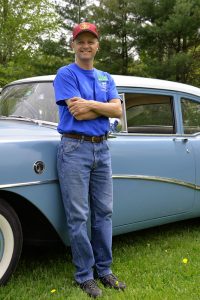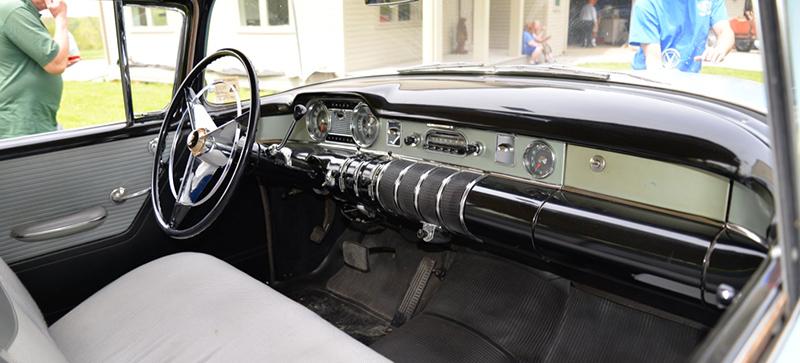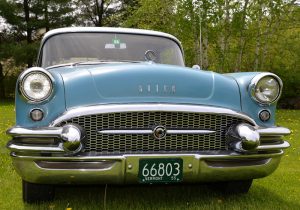A beautiful 1992 Jaguar XJS Elegante owned by Serge Benoit
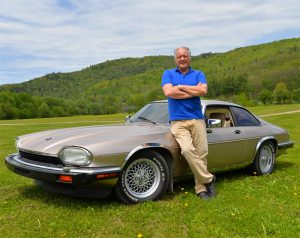 We have all heard about Serge Benoit… or should we say, we have all “heard” Serge Benoit. Serge has been our “French Voice” at our August Antique & Classic Car Meet for many years. He and Gael Boardman keep the show rolling on the public address system at the 60 year old car event.
We have all heard about Serge Benoit… or should we say, we have all “heard” Serge Benoit. Serge has been our “French Voice” at our August Antique & Classic Car Meet for many years. He and Gael Boardman keep the show rolling on the public address system at the 60 year old car event.
Serge lives along the Richelieu River in Sabrevois, Quebec surrounded by, what appears to be, over 1700 square miles of farm land, extending from our border to the St Lawrence River. The vision we Vermonters have is that just a few miles north is Montreal, when all the time there is this beautiful farm land laid out like you would see in our Midwest.
Serge spent over 30 years working for Canadair and Bombardier, both companies very familiar to all of us. He presently works part time for a bus company called “Trans Dev” who operates busses throughout Serge’s area including Montreal, both school busses and transit busses. Serge drives them all. The balance of the time Serge operates the company, he started seventeen years ago called “Eval SB”. If you have your eye on an old car, or even a not-so-old vehicle, you can hire Serge’s company to find if the purchase would be a good idea…or a bad one. His company evaluates 100 to 150 vehicles each year.
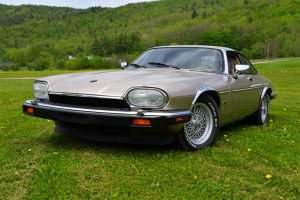 Now to the XJS Jaguar that Serge owns. Serge found the car at an estate sale last November and is the third owner. Other than some brake work, the car was ready to head down the highway….or autoroute, so they say up his way. Jaguar made about 115,000 XJS models between 1975 and 1996 with V12 engines in most of them. The “purists”, so Serge calls them, were protesting the car should also have the 3.6-litre Jaguar AJ6 straight-six engine under the hood. The protest worked and 500 XJSs were built with the six cylinder engine.
Now to the XJS Jaguar that Serge owns. Serge found the car at an estate sale last November and is the third owner. Other than some brake work, the car was ready to head down the highway….or autoroute, so they say up his way. Jaguar made about 115,000 XJS models between 1975 and 1996 with V12 engines in most of them. The “purists”, so Serge calls them, were protesting the car should also have the 3.6-litre Jaguar AJ6 straight-six engine under the hood. The protest worked and 500 XJSs were built with the six cylinder engine.
Serge’s Jag is called the Jaguar XJS Classic and between 1992 and 1996 they made about 8800 2-door coupes and 19,000 2-door convertibles. Transmission choices were the 5-speed automatics (Serge’s car) or the 4-speed manuals.
Jaguar was founded in 1922 and was transformed a number of times with different companies in England, until 1990, when the Ford Motor Company bought Jaguar. Eighteen years later, in 2008, an Indian company by the name of Tata purchased Jaguar and retains ownership today. All Jaguar cars are, however, still built in England.
Sir William Lyons (1901 – 1985), known as “Mr. Jaguar”, was with fellow motorcycle enthusiast William Walmsley, the co-founder in 1922 of the Swallow Sidecar Company, which became Jaguar Cars Limited after the Second World War. Serge said the XJS Jaguar was Mr. Lion’s last “build approval”
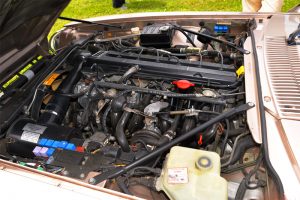 Performance wise, the XJS top speed is 150 MPH with a 0 to 60 of 6 seconds. The six cylinder, 24 valve engine produces 240 HP and the V12 engine puts out close to 300 HP. A little, like what Shelby did to Fords, a performance company by the name of “Lister” was asked to make the XJS perform, straight-up, with a Ferrari…..and they did it. They transformed 90 XJSs into 200mph-plus supercars. At over 600 horse power….we all should have one!
Performance wise, the XJS top speed is 150 MPH with a 0 to 60 of 6 seconds. The six cylinder, 24 valve engine produces 240 HP and the V12 engine puts out close to 300 HP. A little, like what Shelby did to Fords, a performance company by the name of “Lister” was asked to make the XJS perform, straight-up, with a Ferrari…..and they did it. They transformed 90 XJSs into 200mph-plus supercars. At over 600 horse power….we all should have one!
In the meantime, Serge’s car is a Grand Touring Jaguar that replaced the beautiful, legionary XKE……and does a great job carrying on the tradition.










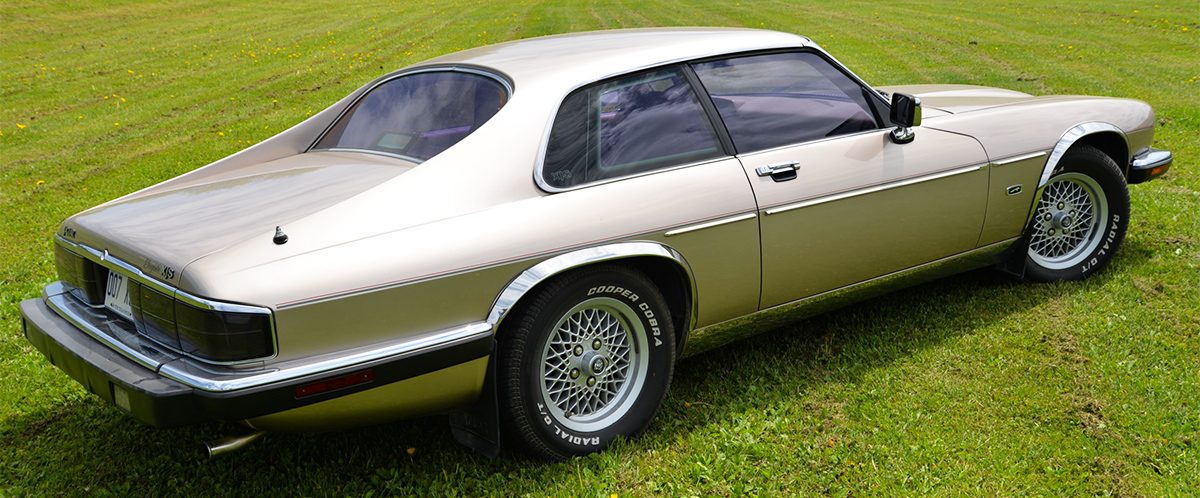

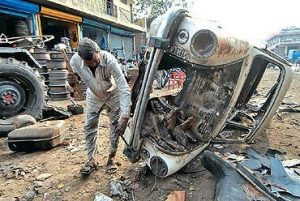


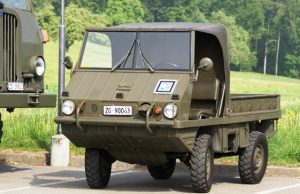
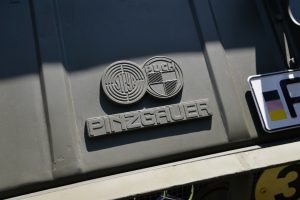
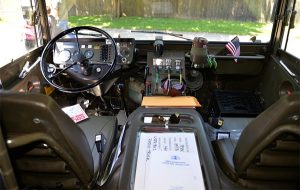
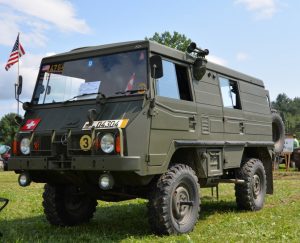

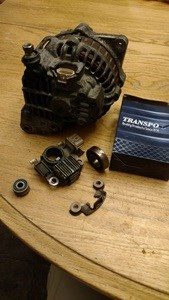 How does one overhaul an alternator? Usually when an alternator wears out, it is due to the wear items reaching the end of their useful life. The wear items in an alternator are the brushes and the bearings. On this alternator, like many alternators, the brushes are part of the regulator assembly. While new brushes can be soldered in to the existing regulator, it is far easier to replace the assembly as a unit.
How does one overhaul an alternator? Usually when an alternator wears out, it is due to the wear items reaching the end of their useful life. The wear items in an alternator are the brushes and the bearings. On this alternator, like many alternators, the brushes are part of the regulator assembly. While new brushes can be soldered in to the existing regulator, it is far easier to replace the assembly as a unit. There are church suppers everywhere… the most popular are chicken and biscuit suppers, but once in a while you will read about a ham dinner or even a game dinner. We’ve been to several in the past month and they are wonderful! A lot of the churches have been putting these suppers on for generations. They have become so popular that reservations are now required. Sometimes there are three “seatings” with take-out available. If you don’t have reservations, you need to get there early. They are usually served family style with refills all the time. We’ve been to a few with friends and it is a great way to see the foliage, visit with friends and catch up on the local gossip.
There are church suppers everywhere… the most popular are chicken and biscuit suppers, but once in a while you will read about a ham dinner or even a game dinner. We’ve been to several in the past month and they are wonderful! A lot of the churches have been putting these suppers on for generations. They have become so popular that reservations are now required. Sometimes there are three “seatings” with take-out available. If you don’t have reservations, you need to get there early. They are usually served family style with refills all the time. We’ve been to a few with friends and it is a great way to see the foliage, visit with friends and catch up on the local gossip. The season for ice cream socials is over, but they are good and lots of fun, too. Often there is music to go with the event which is a nice added feature. Another thing that is happening in recent years are the monthly community suppers that are usually held in local churches and put on by the members of the local church. They are usually free, with a donation basket at the door. You could go to these almost every night of the week if you don’t want to cook. After years of cooking or trying to think of what to cook, the thought of going to these suppers is getting more appealing to me every month. The local church has been hosting these suppers once a month for a number of years now and we rarely miss one. There is a group of us that get together at this supper and you get to visit with people who live in town that you might not see otherwise. Every month there is a different menu and you never know what is being served, until it is posted on the FPF or the Clark’s Truck Center notice board in Jericho, where local events can be posted for free and it is seen by all who travel Route 15.
The season for ice cream socials is over, but they are good and lots of fun, too. Often there is music to go with the event which is a nice added feature. Another thing that is happening in recent years are the monthly community suppers that are usually held in local churches and put on by the members of the local church. They are usually free, with a donation basket at the door. You could go to these almost every night of the week if you don’t want to cook. After years of cooking or trying to think of what to cook, the thought of going to these suppers is getting more appealing to me every month. The local church has been hosting these suppers once a month for a number of years now and we rarely miss one. There is a group of us that get together at this supper and you get to visit with people who live in town that you might not see otherwise. Every month there is a different menu and you never know what is being served, until it is posted on the FPF or the Clark’s Truck Center notice board in Jericho, where local events can be posted for free and it is seen by all who travel Route 15. The Knights of Columbus put on breakfast once a month at a local church that are wonderful. It is another meal where there is a donation basket and the proceeds go to a good cause, whether it is local or not. This is another one we rarely miss, with the same people going, and we usually fill up a whole table…people who we might see only at these breakfasts. You can refill your plate as much as you like, although usually the first pass-through is all that you can eat. Although there might be seconds for bacon. Twice a year, the K of C puts on dinners instead that are delicious. Here, again, they are so popular that reservations are suggested. This also is the season for beer fests and they seem to be happening all the time now. With so many small local breweries and people making their own beer, they are all the rage. The one that takes place in Underhill has lots of food, music, cider making, children’s craft tables and has become a local family event. Rain or shine! Everyone out enjoying themselves before cold weather and darkness settles in and forces us indoors. You should get out the old car and go to one of these. You won’t regret it.
The Knights of Columbus put on breakfast once a month at a local church that are wonderful. It is another meal where there is a donation basket and the proceeds go to a good cause, whether it is local or not. This is another one we rarely miss, with the same people going, and we usually fill up a whole table…people who we might see only at these breakfasts. You can refill your plate as much as you like, although usually the first pass-through is all that you can eat. Although there might be seconds for bacon. Twice a year, the K of C puts on dinners instead that are delicious. Here, again, they are so popular that reservations are suggested. This also is the season for beer fests and they seem to be happening all the time now. With so many small local breweries and people making their own beer, they are all the rage. The one that takes place in Underhill has lots of food, music, cider making, children’s craft tables and has become a local family event. Rain or shine! Everyone out enjoying themselves before cold weather and darkness settles in and forces us indoors. You should get out the old car and go to one of these. You won’t regret it.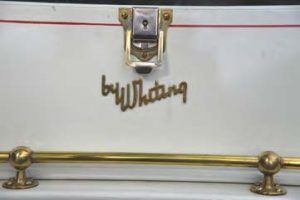
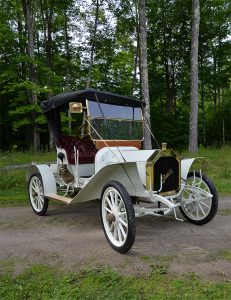
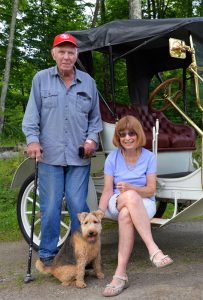


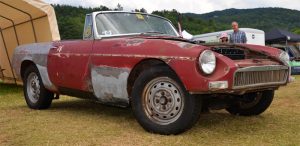
 I have been talking about the negative but you do run into some positive people. The negative occasions you remember, and these are where I would like you to give them a break. I was reminded of this when a group got together recently and while passing through a certain village, remembered the time they were having lunch and this “mad woman” came in the establishment ‘spitting fire’, obviously something they had never seen before or since. I would gather they would not want to see this again! I would have loved to have been there, to hear all the reasons they could give, why this poor distressed woman finally seemed to be on the edge or maybe a little over.
I have been talking about the negative but you do run into some positive people. The negative occasions you remember, and these are where I would like you to give them a break. I was reminded of this when a group got together recently and while passing through a certain village, remembered the time they were having lunch and this “mad woman” came in the establishment ‘spitting fire’, obviously something they had never seen before or since. I would gather they would not want to see this again! I would have loved to have been there, to hear all the reasons they could give, why this poor distressed woman finally seemed to be on the edge or maybe a little over.